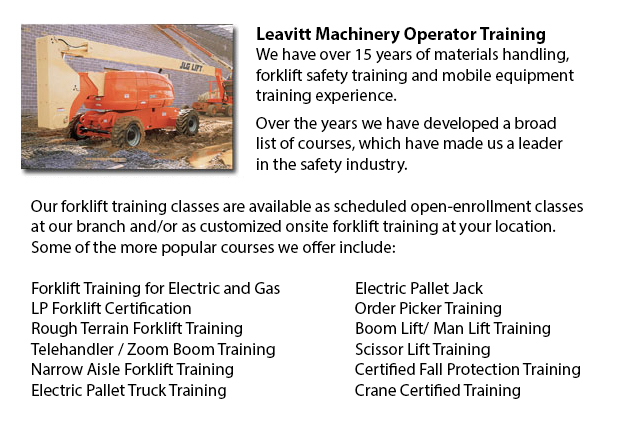
Manlift Training Avondale - Various manlift training programs include the content and review of manlift devices. An essential portion of the program is the practicum where students demonstrate their knowledge and practical ability to safely operate a manlift. A prerequisite to Manlift training is the fall protection training, which can be incorporated in the training based on the particular requirements of the customer.
Course Content
The program content includes: the impact of doing unsafe acts or utilizing unsafe equipment, pre-shift machine check and work area survey requirements, Review of load capacities, Lifting devise equipment definitions, the particular machine requirements and safety decals, Review of related parts of the CSA Standards as well as the OHSA Standards and Review site specific Dangers, together with controls for safely utilizing a lifting device.
Demonstration and Evaluation Content
The evaluation and demonstration part of the course includes: Using a spotter or a signaler when required; Proper personal protective equipment or likewise referred to as P.P.E. as required; Operating a lift only on solid and level ground; Using the proper fitting harness or fall arrest device; Utilizing the lift with all other employees clear of the job location; Aware of load limitations etc. and other specs as set out by the manufacturer; Pre-shift work area survey and equipment inspection; Having all associated machines safely stored on the lift platform; Isolating off the work place when major work projects are to be done; and ensuring a safe and smooth operating speed for various plant conditions
Each and every person would be tested to make sure they could safely and efficiently utilize your site-specific machinery.
Manlift Safety
Since the manlift is capable of lifting materials and personnel more than 20 feet in the air, these equipment pose a particular amount of danger and can be dangerous machines if not utilized correctly. As the danger is so apparent, lift owners and operators are careful to correctly maintain their machinery and follow right safety precautions and operating procedures. The ratio of accidents involving this specific machine is quite low.
The safe use of the boom lift, scissor lift and the manlift is up to the operator of that machinery. They must know all of the responsibilities that go with running the machine and how to utilize the lift vehicle safely. The most basic safety features on the equipment are safety decals and the operating handbook. These show vital information about the safety machinery, maintenance and operating procedures.
Newer lift models would come with guidebooks and decals in place. Technically, the operating handbook should be stored on the lift itself. If you are buying a second-hand lift, it is essential to ensure that the manual is included and that vital decals haven't been painted over. The restraints which prevent operators from falling and the guardrails are other important safety features. These are mandatory and standard on all types of lifts.
-
Forklift Certification Courses Avondale
Forklift Certification Courses Avondale - Forklift certification courses really help to be able to make sure that companies using forklifts, follow the local and regional rules. The drivers of the forklift need to go through forklift certification pr... More -
Manlift Certification Avondale
Manlift Certification Avondale - The Elevated Platforms and Manlifts Certification course helps to provide the required training on the work practices, safe operating procedures, rules and regulations regarding the daily activities for the operators... More -
Manlift Operator Training Avondale
Manlift Operator Training Avondale - The aerial lift or manlift is a specialized type of hydraulic platform that is intended to hoist a person vertically giving it an alternate name of a vertical personnel lift. These machinery are widely used for a... More -
Telescopic Training Avondale
Telescopic Training Avondale - Telescopic Handlers are a type of forklift, normally called telehandlers. This machine has been increasing in popularity because of its greater lift heights and its versatility. It is often preferred over the convention... More -
Heavy Equipment Training Avondale
Heavy Equipment Training Avondale - The two most common types of heavy equipment training are classed into the categories of equipment; equipment that is fashioned with rubber tires or those with tracks. The tracked vehicle are heavy duty equipment l... More -
Aerial Lift Train the Trainer Avondale
Aerial Lift Train the Trainer Avondale - The Aerial Lifts Train the Trainer Certification Program would teach trainers how to efficiently train operators in safe industrial mobile equipment operation. Trainers are provided with in-depth instruction a... More -
Overhead Crane Safety Training Avondale
Overhead Crane Safety Training Avondale - The overhead crane safety training program is meant to equip the operators with the right knowledge and skills in the areas of: crane safety measures, accident avoidance, materials handling, and stock and equ... More -
Heavy Equipment Training Schools Avondale
Heavy Equipment Training Schools Avondale - When choosing an operator training course, there are numerous heavy equipment training schools to select from. In order to ascertain the qualifications you would attain, it is very important to check some a... More

Forklift Training Avondale
TOLL FREE: 1-888-254-6157
Avondale, Arizona
forkliftcertificationavondale.com
Email Us
About Us


